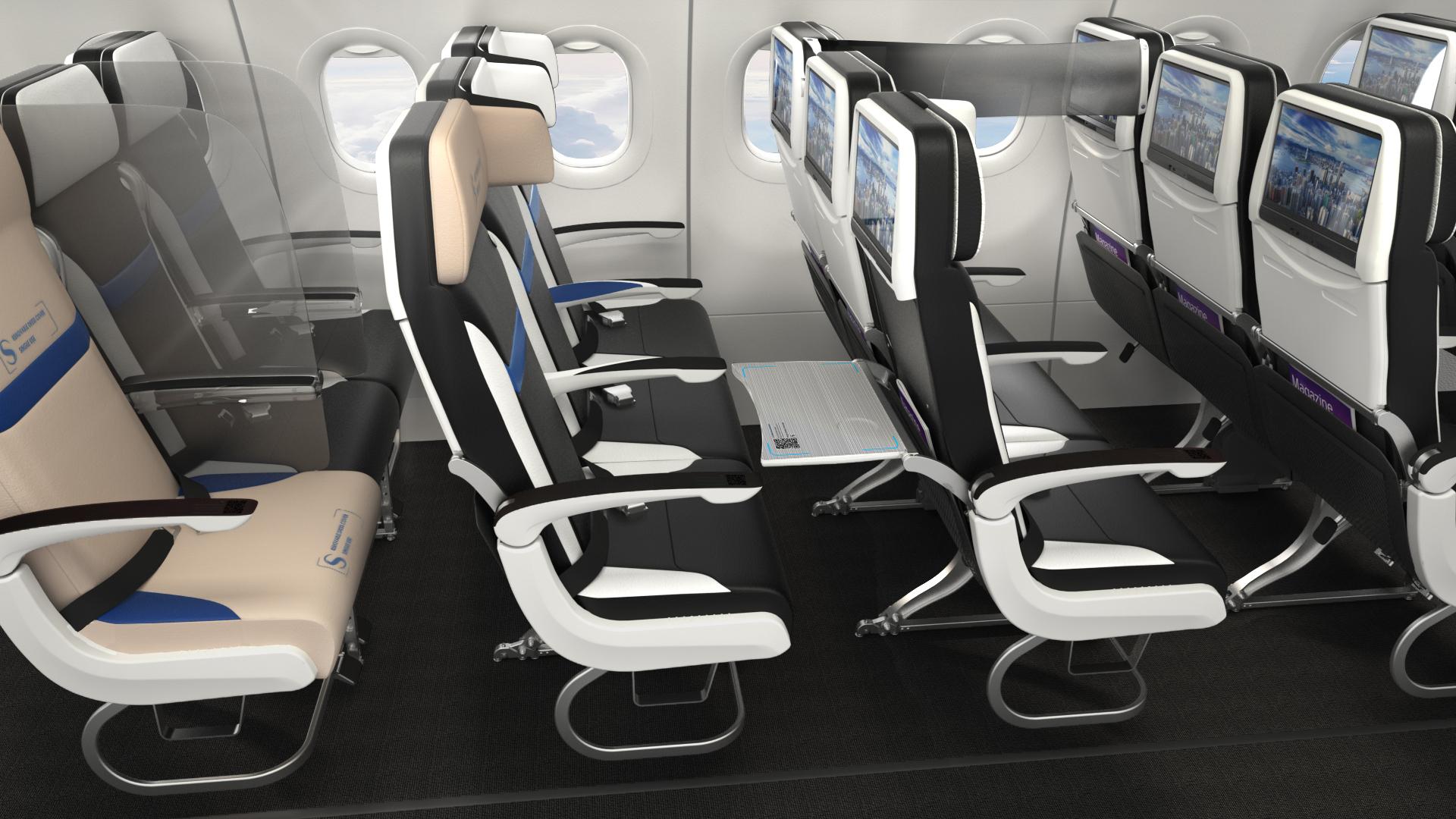キャビン環境向上の新技術が、航空旅行需要の回復につながる可能性

航空会社や航空機メーカーは、乗客のウィルス感染への不安が、旅行需要が収益に見合うレベルまで回復することを妨げているのではないかと心配している。
そのため、業界はあらゆる手段を使って利用者の不安を払拭する動きを取ることになるだろう。
実際、EASA(欧州航空安全機関)の旅客管理ガイドラインのように、民間航空機関はすでに徹底した感染防止策を策定している。EASAの健康安全プロトコルでは、空港での検温やマスクの着用などでこれに対応している。また、既存の空調システムに医療機関レベルのフィルターを追加すれば、利用者の健康が充分に管理されているということに議論の余地はないだろう。
そこまでしているにも関わらず、さらに進んだ対応を取っていることを乗客に示したい航空会社もあるだろう。
Safran社は、各座席を透明のパーティションで区切ることを提案している。「『Ringfence』と呼ばれるパーティションを使えば、座席を仕切りながらも各乗客はアームレストを半分ずつ使うことができる」と語るのは、Safran Seat社の戦略イノベーション担当副社長・Quentin Munier氏だ。
この軽量で取り外し可能なパーティションは、乗客の頭の高さに設置することができ、使い捨ての生地で作ることもできる。また、シートカバーも取り外し可能な使い捨てタイプにすることも可能だ。同じ箇所に複数の乗客が何度も触れることを避けるため、シートのリクライニングやテーブルを足踏み式のペダルで操作できるようにすることも考えている。
Munier氏によれば、アームレストやテーブルには抗菌素材が使われ、乗客はQRコードで座席周りの感染防止策を調べられるようになる。
なお、同氏は「これらはまだアイデアの段階であり、製品化はされていない。実現可能性を検討し、顧客からのフィードバックによって開発の優先順位を決定する」という。
Acro Aircraft Seating社は、様々な素材に抗菌機能を付加する製品を持つAddmaster社との提携を模索している。同社がロンドンの公共交通機関に5年にわたり供給している抗菌化技術「Biomaster」を、アームレストなどの航空機座席向けのパーツに応用したい考えだ。
Acro Aircraft Seating社のインダストリアルデザインを統括しているAl Roots氏は「Biomasterは菌の増殖を最大99.99%抑制できることが確認されており、特に布地や紙といった凹凸のある表面に存在するウィルスに対して高い効果がある。通常の素材に菌が付着すると増殖するが、抗菌生地やプラスチックに付着すると、素材に埋め込まれている銀イオンが菌の増殖を防ぎ、バクテリアは最終的に死滅する」と説明する。
Tapis Corporation社が開発した合成皮革「Promessa」にはすでに銀イオン技術が使用されており、Acro社の製品の一部にも用いられている。
Biomasterは製造工程のどの部分においても添加することができる。Roots氏は「原材料の段階で添加すれば効果が永久に持続するため、それが一番だ。後から布地にスプレーした場合は、80回の水洗浄に耐えることができる」と話した。
また同氏は、Biomasterはあくまで定期的な清掃を補完するものであることを強調している。
なお、素材の性質や耐久性と、新型コロナウィルスに対する効果という2点については、これから試験が行われるところだ。
前者については、Biomasterを添加した場合でも難燃性や洗浄剤への耐性といった特性が変化しないことを確認する必要がある。そうでなければ、再認証が必要だ。
後者の検証はさらに難しい。Roots氏によれば「現状、これを検証できるサービスや製品は存在しない」。ただし、ノロウィルスやネココロナウィルスに対する効果は確認されており、COVID-19に対しても有効と考えられている。
Safran社のMunier氏は、業界はこのような試みを一般化するべきだと考えている。
もうひとつの困難は、この製品をどう呼ぶか、ということだ。バクテリアやカビに対して作用することから「抗菌」ジャンルに入ることになるが、アメリカでは法律上これを「抗ウィルス」と呼ぶことができないと、Roots氏は語る。
また、照明も機内衛生環境の向上につながる。LED照明に特化したAveo Engineering社は、殺菌のための可視/不可視紫外線ライトをプロモーションしている。
同社の品質保証管理を受け持つGeorg Hartl氏は、「波長405ナノメートルの光線が、太陽光に含まれる殺菌力を持った光だ。紫外線は常時照射することができ、通常の白いライトで隠すこともできる。当社ではこれをギャレーと化粧室の清潔を保つために使用している」と語る。
さらに、UV-C光(波長275ナノメートル)は強力な殺菌能力を持つが、人間に対しても有害だ。このため、フライト間の消毒作業に有効とされる。
ただし、シミューションに強みを持つAnsys社は、UV-C光による消毒はあくまで見通し線の範囲にしか効果がないことを指摘している。つまり、殺菌したい表面が光源に対して影に入ってしまうと効果がない。
ここまで紹介してきた技術の土台になるのは、高性能な換気システムだ。
エアバス社のエンジニアリング担当副社長・Jean-Brice Dumont氏によると、機内で乗客が吸う空気は、外気と機内循環の空気で均等に構成される。循環した空気は、医療機関でも使われるHEPAフィルターを通過しており、「これは少なくとも99.9%のウィルスや細菌をブロックすることができる」とDumont氏は語る。
空気は座席上部から吹き出し、床の高さから吸い込まれ、座席の各列が独立した吸排気口を持っている。空気の流れは水平方向と思われがちだが、実際には垂直方向であるため、ウィルスが拡散するリスクは限定的だ。
Dumont氏は「もしあなたが機内でくしゃみをしても飛沫はすぐに吸い込まれ、1分後にはあなたの周りには残っていない」と説明した。
Ansys社による流体力学計算モデルによると、マスクをした乗客がくしゃみをした場合、数個の飛沫がマスクをすり抜けるものの、他の乗客に到達することはまずないことが示されている。
以上は、Thierry DuboisがAviation Dailyいた記事です。 Aviation Dailyは、民間航空に焦点を当てた経営幹部に重要な洞察をお伝えいたします。航空会社と空港の戦略、主要航空会社のデータスナップショット、運賃データ、および国際的なカバレッジを毎日お届けいたします。Aviation Dailyをもっと知りたい場合、こちらをクリックして下さい。
Carriers and aircraft manufacturers worry that the fear of virus propagation may prevent travel eagerness from growing back to profitable levels.
Industry players can therefore be expected to do everything they can to boost passenger confidence.
In fact, action taken by civil aviation authorities, such as EASA’s passenger management guidelines, already sets high prevention standards. EASA’s health safety protocol notably deals with thermal screening at the airport and the use of facial masks. Add the existing air conditioning systems onboard, which include hospital-type filters, and passenger health can arguably be seen as taken care of.
Nevertheless, a carrier may want to show passengers it is going the extra mile to protect them.
Safran suggests seats could be fitted with transparent partition walls. Each “Ringfence” wall would leave half an armrest to each passenger, says Quentin Munier, Safran Seats’ EVP for strategy and innovation.
A lighter design, removable partitions could be installed by passengers at head level. They could be made of single-use, flexible textile. Also single-use could be removable seat covers. To avoid multiple hand contacts with a single item, pedals could control seat recline and tray table position.
Where anti-microbial materials would be used, such as armrests and tray tables, QR codes would enable the passenger to gather information on the surface’s hygienic properties, Munier says.
“These are ideas, not products. We have studied feasibility and, depending on customer feedback, we will prioritize developments,” he says.
Acro Aircraft Seating is exploring a collaboration with Addmaster, a supplier of additives for various materials. The idea is to incorporate the Biomaster anti-microbial technology, which has been in service in London’s public transportation for five years, into aircraft seat parts such as armrests.
“Biomaster is proven to inhibit the growth of microbes by up to 99.99% and it has been proven to be highly effective against viruses on porous surfaces such as textiles and paper. When microbes land on an untreated textile or surface, they multiply. When they land on the surface of an antimicrobial protected fabric or plastic, the silver ions trapped in the surface prevent microbial growth ... and bacteria eventually die,” explains Al Roots, Acro’s head of industrial design.
Silver-ion technology can already be found on Tapis Corporation’s Promessa synthetic leather, which Acro uses for some of its products.
Biomaster can be added at any stage of production. “It best performs if added at the raw material stage, it will last the life of the product,” says Roots. If sprayed on a textile, it can undergo up to 80 cool washes.
Biomaster should be seen as a complement for regular cleaning, Roots emphasizes.
Tests have yet to be conducted in two domains–the retention of the materials’ physical properties and the effectiveness against the COVID-19 virus.
First, the material has to keep its characteristics in flammability and resistance to cleaning agents, for instance, otherwise recertification would be required.
The effectiveness question is more challenging. “There is no commercially available method by which it could be tested,” Roots says. But microbiology studies are encouraging, suggesting that tests conducted against Norovirus and Feline Coronavirus will be valid for the Covid-19 virus.
The industry ought to standardize such trials, notes Safran’s Munier.
Another challenge is describing the product, which can be characterized as “anti-microbial,” as it acts against bacteria and mold. However, U.S. regulation will not allow to call it “anti-viral,” Roots says.
Light could help cabin hygiene, too. Aveo Engineering, a specialist in LED lighting, is promoting the use of visible violet and ultraviolet (UV) light for disinfection purposes.
“The 405 nanometer light is the disinfecting component of the sun light. A violet light can be run all the time and be masked by normal white light. We use these lights for galley and lavatory lights to keep those areas clean,” says Georg Hartl, Aveo’s quality and certification administrator.
Then, UV-C light (at 275 nanometer of wavelength) is for intense disinfection but humans need to be protected. It can be used for disinfection between flights.
Simulation specialist Ansys points out that UV-C disinfection works only under the “line of sight” principle. This means a surface, to be disinfected, must not be masked from the light source.
These technologies will come on top of high-performance ventilation systems.
The air a passenger breathes is evenly composed of fresh air from outside the aircraft and recirculated air, according to Jean-Brice Dumont, Airbus’ EVP for engineering. Recirculated air flows through so-called high-efficiency particulate air (HEPA) filters, which are otherwise used in medical environments. “They block at least 99.9% of viruses and other microbes,” Dumont says.
The air flows from top vents and is sucked at floor level. Every row has its own vents. The fact the air flows vertically, as opposed to horizontally, limits the probability of virus dissemination.
“If you sneeze, droplets will be sucked away and in one minute, there will be nothing left around you,” Dumont says.
A computational fluid dynamics model by Ansys takes the example of a passenger wearing a mask and sneezing. It shows that few droplets make it through the mask and they hardly come close to any other passenger.